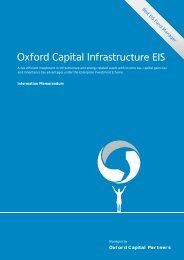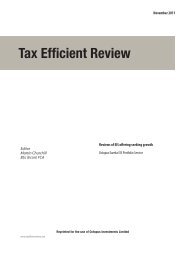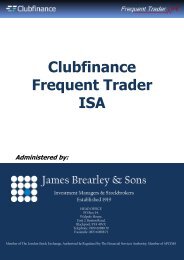OAM2681 OVCT 2 Prospectus aw12 - Clubfinance
OAM2681 OVCT 2 Prospectus aw12 - Clubfinance
OAM2681 OVCT 2 Prospectus aw12 - Clubfinance
Create successful ePaper yourself
Turn your PDF publications into a flip-book with our unique Google optimized e-Paper software.
PART THREE –<br />
THE INVESTMENT OPPORTUNITY<br />
As set out in the investment policy, Octopus VCT 2 will invest in a<br />
portfolio of unquoted companies in a variety of sectors and technologies<br />
where the Octopus team is confident that investments can be<br />
structured with a higher level of capital security with the objective of<br />
building a portfolio of lower-risk investments. Investments made by<br />
the Company will be in a mixture of debt and equity instruments.<br />
Whilst Octopus VCT 2 will have the ability to invest in a variety of<br />
sectors and technologies, the focus will be in the renewable energy<br />
sector, and, in particular, on solar energy. The Octopus team has<br />
significant experience in making such lower-risk investments from<br />
funds raised by VCTs. The investment processes and investee<br />
company objectives below are those particularly applicable to<br />
solar opportunities, but will also apply, as relevant, to other<br />
investment opportunities.<br />
WHY SOLAR<br />
Following recent UK and European legislation, the UK government<br />
has set a target that, by 2020, 30% of all of the UK’s electricity is<br />
generated from renewable sources. Given that only 5.5% is currently<br />
generated from such sources, this is a huge challenge. The UK needs<br />
to build capacity to produce “green electricity” equivalent to 11 new<br />
nuclear power stations. With the possibility of large financial penalties<br />
as well as wider political pressure if the government fails to deliver,<br />
solar is being viewed as an important solution in meeting this<br />
looming deadline.<br />
In April 2010, UK government legislation introduced a Feed-in Tariff<br />
(FIT) regime to the UK. Its aim is to incentivise smaller scale renewable<br />
electricity generation schemes, including ‘solar installations’ – the use<br />
of solar panels to generate electricity. This follows a similar model that<br />
has been used in mainland Europe for a number of years, successfully<br />
encouraging significant roll-out of solar installations using proven<br />
technology. In Germany, for example, one in ten commercial buildings<br />
have solar panels installed and an estimated £42 billion has been<br />
spent on solar installation since it introduced a FIT regime in 2004.<br />
HOW DOES IT WORK<br />
The UK legislation means that the electricity supply companies (not<br />
the UK government) effectively subsidise the cost of installing and<br />
operating solar installations. They do this by guaranteeing to the<br />
owner of the solar installation, the price for the electricity generated.<br />
In addition, the solar installation owner can receive further revenues<br />
from selling the electricity generated to the grid or directly to the end<br />
user (such as the owner of the building upon which the solar panels<br />
are placed).<br />
One of the intentions of the FIT scheme is to encourage the micro<br />
generators of electricity to be located in the same place as the users.<br />
As a result, Octopus VCT 2 will focus on investing in companies that<br />
have received planning permission to own and operate solar installations<br />
on commercial and industrial roof-tops and brownfield sites.<br />
It is expected that the companies in which Octopus VCT 2 will invest<br />
(known as the “investee companies”) will have already agreed terms<br />
with a property owner and obtained planning permission to install<br />
and operate a solar installation prior to the VCT’s investment. The<br />
investee companies will, following investment, be the owner and<br />
operator, but will draw upon experienced third parties in delivering<br />
installation and operation. The investee companies will pay the<br />
property owner for the rent of their roof-top or unused brownfield<br />
site, in addition to potentially supplying the electricity to them.<br />
The landlord therefore obtains a new income stream from an<br />
otherwise redundant space and also the opportunity to fix the price<br />
of electricity that it uses, from the solar power created on the<br />
property owner’s site. The investee company will receive the FIT for<br />
25 years and also revenue from selling electricity to the property<br />
owner. This creates a mutually beneficial arrangement that has the<br />
important positive result of helping the UK government to deliver on<br />
its targets and ultimately reduce our reliance on fossil fuels.<br />
WHY IS SOLAR GOOD FOR LOWER RISK VCT<br />
INVESTMENTS<br />
There are a number of reasons why solar investments under the FIT<br />
scheme are attractive for lower risk VCT investments.<br />
First, solar electricity generation has a proven track record. It is a well<br />
established technology that has been delivered on a large scale over a<br />
number of years outside of the UK.<br />
Secondly, it offers a long-term price for the output that accounts for<br />
inflation. The government legislation stipulates that the payments to<br />
the solar investee companies will remain in place for 25 years, with<br />
the amount paid increasing in line with the Retail Prices Index.<br />
Finally, it delivers predictable volumes of energy, and therefore a<br />
visible revenue stream and return for investors. Despite the inclement<br />
UK weather, it is possible to accurately forecast the level of solar<br />
radiation (sunlight) that can be expected on a site by site basis.<br />
Furthermore, the installation and operating costs of a site can be<br />
projected with some certainty from the outset. This combination, plus<br />
the government’s support for FIT schemes to help achieve its green<br />
energy targets, results in a very visible earnings stream for the owner<br />
and operator of a solar installation. This means Octopus can deliver<br />
an associated level of predictability in the returns generated for<br />
VCT investors.<br />
This predictable underlying investment is then delivered within a VCT<br />
that has been specifically designed to take a lower risk approach. Not<br />
only are the Octopus management fees deferred and only paid when<br />
minimum criteria have been met (see Part Six of this <strong>Prospectus</strong>), but<br />
also the solar operators’ profits are deferred until the investors obtain<br />
their investment back with a hurdle return.<br />
HOW WILL THE OPPORTUNITIES BE STRUCTURED<br />
AND DELIVERED<br />
Octopus has a team of investment professionals with many years of<br />
experience of undertaking lower-risk investments and delivering<br />
dealflow. In addition, in respect of solar energy investments, the team<br />
will work closely with Lightsource Renewable Energy Limited<br />
(“Lightsource”). The Lightsource team is experienced in developing<br />
and operating solar projects, and the combined Octopus and<br />
Lightsource teams have the expertise across the range of skills<br />
required to deliver solar installations including planning, engineering,<br />
property development, legal and financial knowledge, and experience<br />
of rolling-out installations in the established German, Italian and<br />
Spanish markets. Lightsource already has a number of preliminary<br />
agreements in place with well known property owners in preparation<br />
for the roll-out of solar sites.<br />
The Octopus team will source, introduce and structure investment<br />
opportunities for Octopus VCT 2 in respect of solar opportunities,<br />
14
















